Regardless of what industry you’re in, there’s a good chance that you’re working with some kind of dangerous goods. From toxic substances to lithium-ion batteries, dangerous goods encompass a broad range of substances and articles that pose serious risk to the workplaces that carry them. In this post, we explain the classification of dangerous goods in Australia and detail the 9 different classes of dangerous goods, along with their subdivisions.
What are Dangerous Goods?
So, what is the definition of dangerous goods?
Dangerous Goods are substances or articles that pose a risk to people, property or the environment, due to their chemical or physical properties.
In Australia, we look to the Australian Code for the Transport of Dangerous Goods – otherwise known as the Australian Dangerous Goods (ADG) Code – to understand the classification of dangerous goods. While this code may be relevant for transportation of goods, it also extends to how we classify dangerous goods (and their hazards) to ensure the safe handling and storage of chemicals in the workplace.
9 Classes of Dangerous Goods
The 9 classes of dangerous goods include various subdivisions of goods for specific classes. However, we’ll get more into those subdivisions as we look at each class of dangerous goods in the next sections.
Dangerous goods are grouped into these 9 classes:
- Class 1: Explosives
- Class 2: Gases
- Class 3: Flammable liquids
- Class 4: Flammable solids; substances liable to spontaneous combustion; substances which, on contact with water, emit flammable gases
- Class 5: Oxidizing substances and organic peroxides
- Class 6: Toxic substances and infectious substances
- Class 7: Radioactive material
- Class 8: Corrosive substances
REMEMBER: You must always check your safety data sheet (previously known as a material safety data sheet) for each chemical product to determine the dangerous goods class. This will determine how you handle, store and transport the dangerous goods. See Section 14 Transport Information for the dangerous goods class of your goods, as well as the packing group, UN number and other important details.
Understanding Dangerous Goods
The hazards associated with dangerous goods are specific to the dangerous goods class of the chemical. In the next section of our post, we’ll be looking at each class of dangerous goods, so you can get a better understanding of the chemicals that are present in your work environment.
Class 1 – Explosive Substances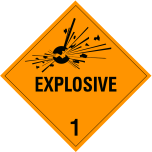
When I think of the term ‘explosive substances’, I think of bombs, war, loud explosions and huge mushroom clouds – things that go ‘bang’. However, not all explosive substances are used for such destructive aims. The stunning fireworks displays we see every year on New Year’s Eve are also a result of a chemical reaction caused by Class 1 substances.
The Australian Dangerous Goods Code defines Explosive Substances as:
A solid or a liquid substance (or a mixture of substances) which is in itself capable by chemical reaction of producing gas at such a temperature and pressure and at such a speed as to cause damage to the surroundings.
Like to find out more about dangerous goods?
Explosive Substances have 6 sub-divisions:
- Division 1.1: Substances and articles which have a mass explosion hazard
- Division 1.2: Substances and articles which have a projection hazard, but not a mass explosion hazard.
- Division 1.3: Substances and articles which have a fire hazard and either a minor blast hazard or a minor projection hazard or both
- Division 1.4: Substances and articles which present no significant hazard; only a small hazard in the event of ignition or initiation during transport with any effects largely confined to the package
- Division 1.5: Very insensitive substances which have a mass explosion hazard
- Division 1.6: Extremely insensitive articles which do not have a mass explosion hazard
Common examples of explosives are:
- Ammunition/Cartridges
- Flares
- Fireworks/pyrotechnics
- Blasting caps/detonators
- Air bag inflators
- Rockets
- PETN/PETN compositions
- TNT/TNT compositions
- RDX/RDX compositions
Class 2 – Gases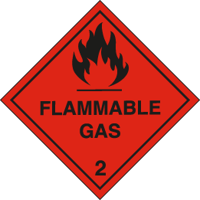
Remember the Hindenburg disaster at New Jersey in May 1937? Most of us weren’t around at the time, but many of us have heard about this terrible incident. The explosion of this airship killed 36 people and was destroyed in 32 seconds; but what was it that caused it? The ignition of Hydrogen – a Class 2.1 Flammable Gas.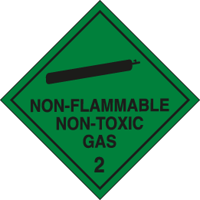
Gases are defined by the ADG Code as:
- A substance which at 50 degrees Celsius has a vapour pressure greater than 300kPa; or
- A substance which is completely gaseous at 20 degrees Celsius at a standard pressure of 101.3 kPa
There are 3 Sub-divisions of Gases:
- Division 2.1: Flammable gases – Gases which at a standard pressure of 101.3 kPa and at 20 degrees Celsius are ignitable when in a mixture of 13 per cent or less by volume with air; or have a flammable range with air of at least 12 percentage points regardless of the lower flammable limit.
- Division 2.2: Non-flammable, non-toxic gases – Gases which dilute or replace the oxygen normally in the atmosphere (asphyxiant gases). Gases which may, generally by providing oxygen, cause or contribute to the combustion of other material more than air does (oxidizing gases).
- Division 2.3: Toxic gases – Gases which are known to be so toxic or corrosive to humans as to pose a hazard to health. Gases which are presumed to be toxic or corrosive to humans because they have an LC50 value (equal to or less than 5000ml/m3)
Common examples of gases are:
- Aerosols
- Gas cartridges
- Compressed air
- Hydrocarbon gas-powered devices
- Fire extinguishers
- Natural gas
- Ethane
- Butane
- Propane
- Ethylene
- Dimethyl ether
Class 3 – Flammable Liquids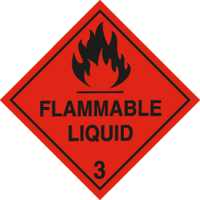
Most people will understand what flammable liquids are, because rely on them every day. Fuel, kerosene, diesel, paint, thinners, ethanol and methylated spirits are all examples of Class 3 liquids. These liquids can pose serious hazards due to their volatility, combustibility and potential in causing or propagating severe conflagrations.
The ADG Code defines flammable liquids as:
Liquids, mixtures of liquids, or liquids containing solids in solution or suspension which give off a flammable vapour at temperatures of not more than 60 degrees Celsius, closed-cup test, or not more than 65.6 degrees Celsius, open-cup test, normally referred to as the flash point.
This class also includes:
- Liquids offered for transport at temperatures at or above their flash point; and
- Substances that are transported or offered for transport at elevated temperatures in a liquid state and which give off a flammable vapour at a temperature at or below the maximum transport temperature.
REMEMBER: There are no sub-divisions within Class 3 dangerous goods.
Common examples of Class 3 Dangerous Goods are:
- Acetone/acetone oils
- Adhesives
- Paints/lacquers/varnishes
- Alcohols
- Perfumery products
- Gasoline/petrol
- Diesel fuel
- Ethanol
- Isopropyls
- Isobutanols
- Octanes
- Methanol
Class 4 – Flammable Solids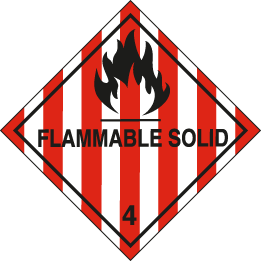
“Flammable solids? What are they? Most things burn if you put a match to them don’t they? So wouldn’t that make most things flammable solids?”
Flammable solids are substances liable to spontaneous combustion – meaning that:
They are liable to burst into flames due to internal heating through exothermic internal reactions, without the addition of heat from an external source; and substances that, in contact with water, emit flammable gases.
Flammable solids can be divided into three divisions:
- Division 4.1 – Flammable solids: These are defined as solids which under conditions encountered in transport, are readily combustible or may cause or contribute to fire through friction; self-reactive substances which are liable to undergo a strongly exothermic reaction; solid desensitized explosives which may explode if not diluted sufficiently.
- Division 4.2 – Substances liable to spontaneous combustion: Substances which are liable to spontaneous heating under normal conditions encountered in transport, or to heating up in contact with air, and being then liable to catch fire.
- Division 4.3 – Substances which in contact with water emit flammable gases: Substances which, by interaction with water are liable to become spontaneously flammable or to give off flammable gases in dangerous quantities.
Common examples of flammable solids are:
- Metal powders
- Alkali metals
- Activated carbon
- Aluminium phosphide
- Metaldehyde
- Copra
- Naphthalene
Class 5 – Oxidizing Substances; Organic Peroxides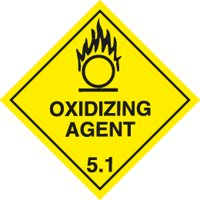
Oxidizing substances and organic peroxides are used extensively around us without most of us even knowing. They are found in the agricultural industry in fertilisers and in the pharmaceutical industry in medications. Class 5 substances are often used in high school and college laboratories to conduct reduction and oxidization experiments.
Believe it or not – they are even used in toothpaste: Calcium peroxide in toothpaste decomposes when it meets water to form a small amount of hydrogen peroxide, which then whitens the teeth!
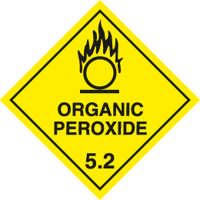
Class 5 dangerous goods are divided into two divisions and are described by the ADG Code as follows:
- Division 5.1 – Oxidizing substances: Substances which, while in themselves not necessarily combustible, may, generally by yielding oxygen, cause, or contribute to, the combustion of other material. Such substances may be contained in an article.
- Division 5.2 – Organic Peroxides: Organic substances which contain the bivalent -0-0- structure and may be considered derivatives of hydrogen peroxide, where one or both of the hydrogen atoms have been replaced by organic radicals. Organic peroxides are thermally unstable substances which may undergo exothermic self-accelerating decomposition. In addition, they may have one or more of the following properties:
- (i) Be liable to explosive decomposition;
- (ii) Burn rapidly;
- (iii) be sensitive to impact or friction;
- (iv) React dangerously with other substances;
- (v) Cause damage to eyes.
Common examples of Class 5 Dangerous Goods are:
- Permanganates
- Perchlorates
- Ammonium nitrate fertilizers
- Chlorates
- Hydrogen peroxide
- Magnesium peroxide
- Lithium hypochlorite
- Potassium perchlorate
- Sodium nitrate
CLASS 6 – Toxic Substances; Infectious Substances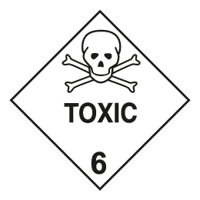
Class 6 Toxic and Infectious Substances are also used widely around us, especially in the agricultural industry for use in pesticides. They are also used extensively in the medical industry as they have important physiological effects on humans, for example, morphine, strychnine, quinine and chloroform.
Class 6 substances are divided into two subdivisions and are defined by the ADG Code as below:
- Division 6.1 – Toxic Substances: These are substances liable either to cause death or serious injury or to harm human health if swallowed or inhaled or by skin contact.
- Division 6.2 – infectious substances: These are substances known or reasonably expected to contain pathogens. Pathogens are defined as micro-organisms (including bacteria, viruses, rickettsiae, parasites, fungi) and other agents such as prions, which can cause disease in humans or animals.
Common examples of Class 6 substances are:
- Clinical waste
- Medical cultures / samples / specimens
- Medical/Biomedical waste
- Tear gas substances
- Acids
- Arsenates
- Lead compounds
- Antimony
- Adiponitrile
- Chloroform
Class 7 – Radioactive Material
Everyone has heard of Hiroshima and Nagasaki – the atomic bombs dropped on these cities caused hundreds of thousands of civilian casualties and brought about the end of World War 2. These explosions were a result of atoms with an unstable nucleus undergoing radioactive decay – Uranium and Plutonium fission bombs.
However, not all radioactive material is used in such a destructive manner. Radioactive material is also used in the medical industry in the form of nuclear medicine, which involves the application of radioactive substances in the diagnosis and treatment of disease.
REMEMBER: There are no subdivisions for Class 7 dangerous goods.
The ADG code defines this class as below:
Radioactive material means any material containing radionuclides where both the activity concentration and the total activity in the consignment exceed the values specified in 2.7.2.2.1 to 2.7.2.2.6.
A radioactive nucleotide is an atom which an unstable nucleus which emits excess energy as alpha or beta particles or as gamma rays. Unstable nucleus’s undergo radioactive decay to achieve a more stable state.
Common examples of radioactive materials are:
- Enriched Uranium
- Caesium radionuclides / isotopes
- Surface contaminated objects
- Medical isotopes
- Yellowcake
- Uranium hexafluoride
- Radioactive ores
Class 8 - Corrosives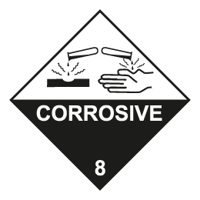
Corrosives are found in a variety of common household and workplace items, including batteries, dyes and cleaning chemicals. Corrosive substances are grouped into two main types, those being acids and alkalis. Acids are corrosive chemicals with a pH level less than 7, while alkalis have a pH level greater than 7. All corrosive substances pose harm to people, property and the environment due to their ability to corrode living tissue and materials, such as stone and metal.
REMEMBER: There are no subdivisions for Class 8 Dangerous Goods.
The ADG code defines Class 8 Corrosive substances as:
Class 8 substances (corrosive substances) are substances which, by chemical action, will cause severe damage when in contact with living tissue, or, in the case of leakage, will materially damage, or even destroy, other goods or the means of transport.
Common examples of corrosive substances are:
- Fuel cell cartridges
- Flux
- Battery fluid
- Dyes
- Hydrochloric acid
- Sulfuric acid
- Hydrogen fluoride
- Nitric acid
- Iodine
Class 9 – Miscellaneous Dangerous Goods
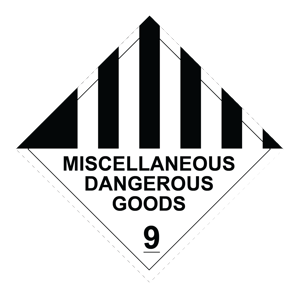
“Miscellaneous dangerous goods? I suppose that means a mixture of all the previous classes, does it?” The answer to that question, is no.
Instead, the ADG code gives us the following defintions:
Class 9 substances and articles (miscellaneous dangerous substances and articles) are substances and articles which, during transport present a danger not covered by other classes.
Genetically modified micro-organisms (GMMOs) and genetically modified organisms (GMOs) are micro-organisms and organisms in which genetic material has been purposely altered through genetic engineering in a way that does not occur naturally.
Miscellaneous dangerous goods present a wide variety of potential hazards to human health and safety, as well as also presenting hazards to infrastructure and/or their means of transport.
Common examples of miscellaneous dangerous goods are:
- Expandable polymeric beads / polystyrene beads
- Ammonium nitrate fertilizers
- Dry ice / cardice / solid carbon dioxide
- Lithium-ion batteries
- Lithium metal batteries
- Battery powered equipment
- Blue asbestos / crocidolite
- First aid kits
- Air bag modules
- Castor bean plant products
- Plastics moulding compound
- Polychlorinated biphenyls
- Polychlorinated terphenyls
Dangerous Goods Safety
As you can see, there are dangerous goods examples all around us — particularly in the workplace. Due to the many risks dangerous goods pose to people, property and the environment, it is essential to store these safely and compliantly to minimise any potential harm that could be caused. It’s important that every organisation, large or small, makes sure that the storage of their dangerous goods complies with the requirements set out in the Australian Standards. This will ensure that your goods are stored to properly minimise their hazards and create a safe environment for your staff, customers and community.
Segregating incompatible dangerous goods is also essential for site safety. If you’d like to learn more about dangerous goods segregation, you can access our FREE eBook which details how to segregate the various classes of dangerous goods at your site to minimise hazards. Grab your eBook copy today.
Joining the team as a Dangerous Goods Storage Consultant, Melissa Hampton became Storemasta's Marketing Manager in late 2021. With extensive knowledge and experience in chemical compliance, Melissa is responsible for leading the Marketing team and helping shape their marketing strategy. In her spare time, you can find Melissa hiking, swimming and enjoying the great outdoors in beautiful north-west Tasmania.

